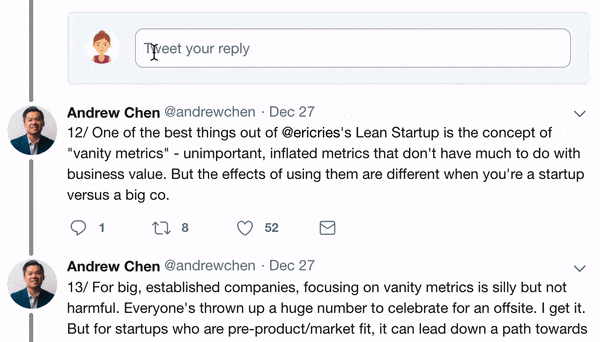
1/ A 4-part thread on trade planning. Part 1
This is an amalgam of a lot of reading, so it isn’t attributable to a single source. This functions as the framework for my trading.
Some definitions:
This is an amalgam of a lot of reading, so it isn’t attributable to a single source. This functions as the framework for my trading.
Some definitions:
2/
A trade succeeds or fails if it works as it is designed. Success and failure isn't winning or losing. You can lose but have a successful trade.
Return to Risk (R/R) = (Probability of success * reward)/(Probability of failure * risk). Should be >1 every trade
A trade succeeds or fails if it works as it is designed. Success and failure isn't winning or losing. You can lose but have a successful trade.
Return to Risk (R/R) = (Probability of success * reward)/(Probability of failure * risk). Should be >1 every trade
3/
Your trade thesis is what about the market your trade is trying to capitalize in your favor.
The natural flow of a trade is: edge -> setup -> trade plan -> execution. If any of them are lacking, your trade’s success chance plummets, but they can inform each other.
Your trade thesis is what about the market your trade is trying to capitalize in your favor.
The natural flow of a trade is: edge -> setup -> trade plan -> execution. If any of them are lacking, your trade’s success chance plummets, but they can inform each other.
4/
Every time your trade fails, it fails at one of those areas. Let’s take a dive into each of these concepts, but backwards, because that’s how each of these are recognized in your trading.
First, Execution.
Every time your trade fails, it fails at one of those areas. Let’s take a dive into each of these concepts, but backwards, because that’s how each of these are recognized in your trading.
First, Execution.
5/
Execution is the implementation of your trade plan. When you have a deficiency in execution (e.g. you hold past a stop, you do not take profits when you initially planned to, you enter a trade despite no setup due to a feeling), you implicitly rely on your gut to plan.
Execution is the implementation of your trade plan. When you have a deficiency in execution (e.g. you hold past a stop, you do not take profits when you initially planned to, you enter a trade despite no setup due to a feeling), you implicitly rely on your gut to plan.
6/
You can also have an excess of execution, where you follow your initial trade plan exactly. This ignores that the thesis can change from the time you put the trade on. As a result, you may not trade optimally. An example in $AAPL
You can also have an excess of execution, where you follow your initial trade plan exactly. This ignores that the thesis can change from the time you put the trade on. As a result, you may not trade optimally. An example in $AAPL
7/
I believe iPhone sales will 4x in 1 yr, and result in a 25% rise in $AAPL. Earnings reveal Airpod sales shoot up, and $AAPL is +25% and I sell despite no fundamental change in iPhone sales. iPhone sales 4x in one year and $AAPL is +55% since the buy. oops.
I believe iPhone sales will 4x in 1 yr, and result in a 25% rise in $AAPL. Earnings reveal Airpod sales shoot up, and $AAPL is +25% and I sell despite no fundamental change in iPhone sales. iPhone sales 4x in one year and $AAPL is +55% since the buy. oops.
8/
Execution is the part of the trade that algorithms try to solve. The goal is to take the emotion out of the trading, but to use AI to try to keep the logic in the trade. Most algos I have seen (not all) I feel are an excess in execution.
Execution is the part of the trade that algorithms try to solve. The goal is to take the emotion out of the trading, but to use AI to try to keep the logic in the trade. Most algos I have seen (not all) I feel are an excess in execution.
9/
They attempt to balance a portfolio perfectly, execute on exact terms, or use machine learning to trade on previous conditions. However, portfolios and terms should change with market conditions, and machines can learn a lot but their edge needs to be confirmed. Most are not.
They attempt to balance a portfolio perfectly, execute on exact terms, or use machine learning to trade on previous conditions. However, portfolios and terms should change with market conditions, and machines can learn a lot but their edge needs to be confirmed. Most are not.
10/
Ideal execution is data-backed, consistent with your thesis, and extracts your edge. Money is involved so emotion plays a part. If sizing your trade appropriately doesn't help, I recommend reading "The Psychology of Trading" by Brett Steenbarger.
Tomorrow: Trade Plans
Ideal execution is data-backed, consistent with your thesis, and extracts your edge. Money is involved so emotion plays a part. If sizing your trade appropriately doesn't help, I recommend reading "The Psychology of Trading" by Brett Steenbarger.
Tomorrow: Trade Plans
• • •
Missing some Tweet in this thread? You can try to
force a refresh




